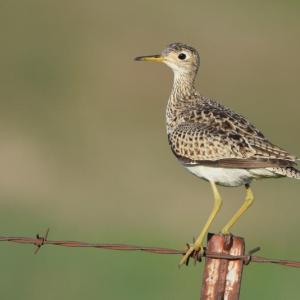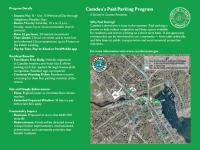A Sound You Will Never Forget
 Upland sandpipers, a bird of open grasslands, will sometimes perch on human-made structures like fences as well as on bushes and shrubs, making it easy to see their mottled plumage, long bill and legs, and large, dark eye. Photo by Wild Return, courtesy Wikimedia Commons
Upland sandpipers, a bird of open grasslands, will sometimes perch on human-made structures like fences as well as on bushes and shrubs, making it easy to see their mottled plumage, long bill and legs, and large, dark eye. Photo by Wild Return, courtesy Wikimedia Commons
 Female upland sandpipers land their four eggs in a shallow cup in the ground, often in thick grass or under cover of low bushes. Photo by Tom Koerner/USFWS, courtesy of Wikimedia Commons
Female upland sandpipers land their four eggs in a shallow cup in the ground, often in thick grass or under cover of low bushes. Photo by Tom Koerner/USFWS, courtesy of Wikimedia Commons
 Upland sandpipers, a bird of open grasslands, will sometimes perch on human-made structures like fences as well as on bushes and shrubs, making it easy to see their mottled plumage, long bill and legs, and large, dark eye. Photo by Wild Return, courtesy Wikimedia Commons
Upland sandpipers, a bird of open grasslands, will sometimes perch on human-made structures like fences as well as on bushes and shrubs, making it easy to see their mottled plumage, long bill and legs, and large, dark eye. Photo by Wild Return, courtesy Wikimedia Commons
 Female upland sandpipers land their four eggs in a shallow cup in the ground, often in thick grass or under cover of low bushes. Photo by Tom Koerner/USFWS, courtesy of Wikimedia Commons
Female upland sandpipers land their four eggs in a shallow cup in the ground, often in thick grass or under cover of low bushes. Photo by Tom Koerner/USFWS, courtesy of Wikimedia Commons
The first time you clearly hear the long, drawn-out whistled “weet-woo” of an upland sandpiper drifting into your ears across an open grassland or blueberry barren, you will be mesmerized. Some have likened the sound to be as resonating as the cry of the loon, or howl of a wolf.
The upland sandpiper is a long-legged, long-necked bird roughly about half the size of a crow. It has yellow legs and a mostly yellow bill, with mottled brown-and-white plumage and a dark eye that looks too small for its small head.
Most other sandpipers are birds of wetlands, but the upland sandpiper nests in dry grasslands, pastures, and blueberry barrens here in the northeastern U.S. and adjoining Canada. Its plumage can make it remarkably hard to see among the shades of tan and brown that dominate its preferred habitat.
Soon after arrival in the spring, birds fly up high above the open grasslands where they are nesting and give their distinctive whistled vocalization from so high up that it can be difficult to spot them, especially on a blue sky day. When your eyes to find them, you may see them fluttering and then turning into the wind to hang motionless on stiff wings for a moment while they utter that distinctive whistled song.
The female lays her four eggs in a shallow cup nest on the ground hidden in thick grass or under blueberry plants or low shrubs. The young are already covered in down when they hatch; they leave the nest with one or both adults within in a day or two. The chicks quickly learn to feed themselves, though one or both adults stay near them through the growth period until they can fly. This is usually about month after hatching.
Amazingly, upland sandpipers—adults as well as young of the year—migrate south all the way to the grasslands of southern South America for the winter.
Upland sandpiper populations have had many ups and downs over the years. In the 1800s, they expanded their range from their prairies into New England as forests were cleared and replaced by pastures and hayfields. In the late 1800s and early 1900s, the birds were targeted by market hunters who killed thousands to send to city markets. Unlike the passenger pigeon and the Eskimo curlew, both of which became extinct from market hunting around this same time, upland sandpipers survived in some locations. Their populations increased after the Migratory Bird Treaty was signed in 1916 and hunting regulations came into force for migratory species like this.
In Maine, numbers of upland sandpipers increased around this time. The birds began inhabiting more hayfields and blueberry barrens.
In recent decades, upland sandpipers have been disappearing from much of the landscape of the state. They now occur in just a few spots in the southern half of the state, although they still remain more abundant in the extensive blueberry barrens of Washington and Hancock counties.
One of the few places in our area where upland sandpipers still persist is at the former naval air base in Brunswick. Since we were first awestruck by the wonderful plaintive whistle of the upland sandpiper many years ago, we always long to hear it again at least once a summer. We felt blessed to hear several upland sandpipers this year at the north end of the former base in Brunswick from the perimeter road that is open to bikes and foot traffic. We were even lucky enough to see a couple of chicks there recently, safe from human disturbance behind the fence that surrounds the area. Hopefully those little chicks will grow up successfully, make it to South America for the winter, and then back again to Brunswick, Maine, in the spring so that there will be upland sandpipers there for years to come.
Jeffrey V. Wells, Ph.D., is a Fellow of the Cornell Lab of Ornithology and Vice President of Boreal Conservation for National Audubon. Dr. Wells is one of the nation's leading bird experts and conservation biologists. He is a coauthor of the seminal “Birds of Maine” book and author of the “Birder’s Conservation Handbook.” His grandfather, the late John Chase, was a columnist for the Boothbay Register for many years. Allison Childs Wells, formerly of the Cornell Lab of Ornithology, is a senior director at the Natural Resources Council of Maine, a nonprofit membership organization working statewide to protect the nature of Maine. Both are widely published natural history writers and are the authors of the popular books, “Maine’s Favorite Birds” (Down East Books) and “Birds of Aruba, Bonaire, and Curaçao: A Site and Field Guide,” (Cornell University Press).

























